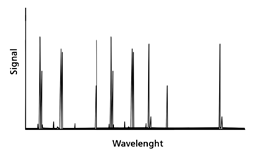- inductively coupled plasma atomic emission spectroscopy (icpaes) / inductively coupled plasma mass spectrometry (icp-ms) / laser ablation inductively coupled plasma mass spectrometry (la-icp-ms) -
Uses an inductively coupled plasma source to yield elemental information from samples
dating
morphology
technology
origin
composition
alteration

Ceramic

Glass

Metal

Mortar

Stone
Ceramic Building Materials (CBM) & Glass
ICP-AES and LA-ICP-MS are commonly used for determining the composition of CBM (bricks and tiles), and for investigating siliceous materials, like glass or ceramic glazes. Trace or rare elements detected in their matrix can help differentiate similar ceramic or glass materials, or provide evidence on the provenance of the raw materials and help assessing ancient trade routes, while the characterization of colouring agents can also provide information about their production period.
Metals & Alloys
ICP analyses of a statistically representative number of metal and alloy samples can yield information regarding their provenance. The chemical composition of residual inclusions in metallic artefacts can also indicate the process and conditions under which they were manufactured or help discriminate their production period (Dillman & L’ Héritier, 2007).
Stone, Mortar & Plaster
ICP techniques are used to characterize historic building stone material and/or to classify mortars according to the chemical composition of their components. It is also used to detect any possible mineral structure changes caused by weathering that may aff ect their structural health (Friolo et al., 2003).

ICP-AES spectrum
Inductively Coupled Plasma (ICP) Techniques are powerful due to their accurate and precise trace element detection capability and very low detection limits (ppm-range for solids and ppb-range for solutions). All ICP techniques are based on the use of an inductively coupled plasma* excitation source allowing to perform qualitative and quantitative elemental analysis on both organic and inorganic samples. They are distinguished in three type of analysis
- ICP-AES, delivering a spectrum with peaks relating tcontaining peaks corresponding to the wavelength of emission of each element detected (on the X-axis) and its concentration (on the Y-axis).
- ICP-MS, with output a mass spectrum with peaks corresponding to the sample’s elements (on the X-axis) and their concentration (on the Y-axis) (Fig. 1).
- LA-ICP-MS — uses a laser to directly convert solid samples into an aerosol. The laser beam focuses, fires and drills on the sample’s surface, removing material from it, which is transported by means of a gas flow to an ICP-MS, where ionization takes place. Ions are then separated according to their mass-to-charge ratio.
Despite the techniques having similar names, they are actually two different techniques: ICP-AES is an optical emission technique, while ICP-MS is a mass spectrometry method with an ICP excitation source. Both analytical techniques use an argon plasma. However,the plasma in ICP-AES serves to excite atoms and ions to higher energy states after which the spectrometer detects the photons emitted by these atoms and ions as they return to their normal states, whereas in the ICP-MS method the plasma generates individual atoms and ions which are then transported to the mass spectrometer and separated on the basis of their mass-to-charge ratio.
Both ICP-MS and ICP-AES provide elemental information of the analysed samples. Generally, ICP-MS is used to determine ppb-concentration levels, whereas ICP-AES is used to determine concentrations in the ppm-range.
accuracy
time
cost
in situ
invasive
destructive
An inductively coupled plasma (ICP) source is a high energy and temperature (7.000 – 10.000ºK) excitation source, usually produced by ionising a flowing gas, such as Argon, in a coil. The ICP is used to excite and ionize the sample’s atoms. These atoms undergo de-excitation transitions in order to return to a stable state while spontaneously emitting electromagnetic radiation at wavelengths characteristic of the sample’s elements.